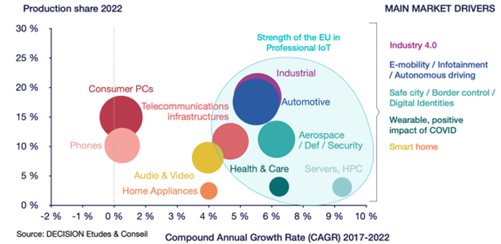
iStock photo Getty images plus
The progression of digital technology in Europe underscores a clear trend towards edge computing. This approach, rooted in pragmatism, highlights the significance of processing data closer to its source, emphasising efficiency and autonomy.
Edge computing is essentially about decentralising data processing, moving it from distant data centres to proximate locations. A key component driving this transition is the shift of computing capacity to the edge. The term "thick computing", refers to the integration of high-performance chips into connected objects and systems, such as future cars, enabling them to process complex computational tasks locally. These offer faster response times and allow for autonomous decisions to be taken locally.
A recent study by DECISION provides greater insight into this field, suggesting that edge computing in Europe is evolving, with significant growth potential, especially in areas of professional IoT where Europe’s industry is strong to compete globally. In particular, there is a high potential for European semiconductor companies to strengthen their position in their traditional strongholds due to the increasing demand from the EU professional IoT manufacturers.
Figure 1 illustrates the Production Share in 2022 versus the Compound Annual Growth Rate (CAGR) from 2017-2022 for various sectors. Notably, the strength of the EU in Professional IoT is pronounced in sectors like Industrial, Automotive, Health and Aerospace/Defence/Security. Market trends indicate steady growth in sectors like Industry 4.0, E-mobility, energy and wearable technology.

Figure 1: Growth trends in electronic systems influenced by Professional IoT
Looking more broadly at the global market for thick computing, Figure 2 shows that Professional IoT displays steady growth, increasing from €29 billion in 2021 to an anticipated €59 billion by 2027, at a growth rate of 12% per year. By 2027, the sectoral distribution indicates security (cameras & IDS) as the largest segment at 36%, followed by automotive at 20%, health & care at 18%, factory automation at 16%, and energy management at 10%.
![]()
Figure 2: Growth trends in the thick computing semiconductors market
The European Commission is not only endorsing the importance of thick computing in Industrial IoT but also paving the way for Europe to be a significant player in this space. Under its research and innovation programme HORIZON EUROPE, the Commission earmarks €45 million for pilot actions on Digital Platforms for the Cloud-Edge-IoT, aimed at fostering collaborations between industries and academia and demonstrating emerging edge solutions in realistic environments. Through its global investments, exceeding €250 million, in the Cloud-Edge-IoT area since 2021 (more information on the European Cloud, Edge and IoT Continuum Initiative), the Commission supports emerging edge paradigms, nurtures a vibrant ecosystem encompassing open-source communities and SMEs, thereby ensuring that Europe capitalises on the opportunities presented by the growing market. This commitment further solidifies the Union’s aspirations to be at the forefront of the global edge computing landscape and aligns with its policy to support the green and digital transition of Europe’s economy.
For Europe, this evolution has several implications:
· Technological advancement and early adoption by key industries: The opportunity for Europe to further its position in the tech industry.
· Digital Sovereignty: Promoting partnerships between European industry and semiconductor suppliers benefiting from a massive investment in chip design and supply under the Chips Act.
· Sustainability focus: As Europe adopts edge computing, the adoption of edge solutions reduce greenhouse gas emission in key industrial sectors as well as there's a responsibility to ensure balanced sustainable considerations.
To conclude, the DECISION study serves as a guide, outlining the opportunities for Europe’s key industries in the field of edge computing. This structured economic perspective provides a strategic analysis on key market potentials and adoption factors ensuring steady growth in the digital landscape and serves as valuable background for the up-coming calls on large-scale pilots in 2024.
For those interested in diving deeper into this topic, detailed findings are available in the study report, shedding light on Europe's pragmatic approach in edge computing and its potential outcomes.
Final study report, executive summary and abstract
Information and Brokerage Session
An Information and Brokerage Session on the pilot call on Digital Platforms for the Cloud-Edge-IoT will be an integral part of the Horizon Europe Information and Brokerage Event on 4 December 2023, from 9:00 – 15:00 CET. Registration is open until 4 December.
More information on the event and how to register
